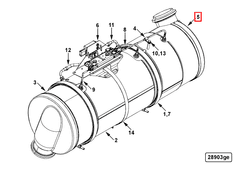This truck part is made by Cummins®. We guarantee that all of our parts are from the OEM (original equipment manufacturer), ensuring a proper fit and quality manufacturing.
We honor the warranty provided by the original equipment manufacturer.
Introduction
The Cummins 2871569 Inlet Catalyst Module is a critical component designed for use in heavy-duty trucks. It plays a significant role in the exhaust system, contributing to the overall efficiency and environmental compliance of the vehicle. This module is part of Cummins Inc.’s extensive portfolio of diesel engine components, renowned for their reliability and performance.
Basic Concepts
The Inlet Catalyst Module operates on the fundamental principle of catalyzing exhaust gases to reduce harmful emissions. Positioned within the exhaust system, it interacts with the gases produced by the engine, facilitating chemical reactions that convert pollutants into less harmful substances. This process is integral to meeting stringent emission standards and ensuring the truck operates within regulatory limits 1.
Purpose and Function
The primary role of the 2871569 Inlet Catalyst Module is to enhance the emission control system of a truck. By catalyzing exhaust gases, it plays a part in reducing the levels of nitrogen oxides (NOx) and other pollutants. This not only contributes to a cleaner environment but also helps in maintaining engine performance by ensuring the exhaust system operates efficiently 2.
Key Features
The Cummins 2871569 Inlet Catalyst Module is characterized by its robust design and the use of high-quality materials. It incorporates advanced catalytic technologies that enable it to effectively process exhaust gases. The module is engineered to withstand the high temperatures and pressures typical of heavy-duty truck exhaust systems, ensuring durability and reliability.
Benefits
Incorporating the 2871569 Inlet Catalyst Module into a truck’s exhaust system offers several advantages. It contributes to improved fuel efficiency by optimizing the exhaust flow, reduces emissions to help meet environmental regulations, and enhances overall engine performance. These benefits make it a valuable component for truck operators looking to balance performance with compliance.
Installation Process
Installing the 2871569 Inlet Catalyst Module requires careful attention to ensure it is properly integrated into the exhaust system. The process involves securing the module in place using appropriate fasteners, ensuring all connections are tight to prevent leaks, and verifying that it is correctly aligned with other components in the system. Tools required may include wrenches and torque wrenches to achieve the correct fastening torque.
Maintenance and Care
To ensure the optimal performance and longevity of the 2871569 Inlet Catalyst Module, regular maintenance is recommended. This includes periodic inspections for signs of wear or damage, cleaning the module to remove any buildup that could impede its function, and ensuring all connections remain secure. Adhering to these maintenance practices helps in preserving the efficiency of the emission control system.
Troubleshooting Common Issues
Common issues with the 2871569 Inlet Catalyst Module may include reduced efficiency due to contamination or physical damage. Troubleshooting steps involve inspecting the module for any visible damage, cleaning it to remove contaminants, and checking the exhaust system for leaks or obstructions that could affect its performance. Addressing these issues promptly helps in maintaining the module’s effectiveness.
Regulatory Compliance
The 2871569 Inlet Catalyst Module plays a role in helping trucks meet emissions regulations and standards. By reducing the levels of pollutants in the exhaust, it contributes to minimizing the environmental impact of heavy-duty trucks. Compliance with these regulations is crucial for operators to avoid penalties and contribute to environmental sustainability.
Cummins Overview
Cummins Inc. is a global power leader that designs, manufactures, and distributes diesel and natural gas engines, as well as related technologies. With a history of innovation and a commitment to quality, Cummins has established itself as a trusted name in the diesel engine and component manufacturing industry. The company’s expertise in emission control technologies underscores its dedication to environmental stewardship and performance excellence.
Role of Part 2871569 Inlet Catalyst Module in Engine Systems
The 2871569 Inlet Catalyst Module is an integral component in the aftertreatment system of modern engines. It is strategically positioned to optimize the efficiency of the exhaust gas treatment process.
When exhaust gases exit the engine, they pass through the turbocharger, where residual energy is harnessed to increase airflow into the engine. Following this, the gases enter the Inlet Catalyst Module. Here, the module initiates the reduction of harmful emissions by catalyzing chemical reactions that convert pollutants into less harmful substances.
The module works in conjunction with the Diesel Oxidation Catalyst (DOC), which further reduces hydrocarbons and carbon monoxide. Downstream, the gases move into the Selective Catalytic Reduction (SCR) system, where urea is injected to convert nitrogen oxides into nitrogen and water vapor.
The Inlet Catalyst Module ensures that the exhaust stream is adequately prepared for these subsequent treatments, enhancing the overall effectiveness of the aftertreatment device. Its placement and function are designed to maintain optimal operating temperatures and flow rates, contributing to the durability and performance of the entire exhaust system.
Conclusion
The Cummins 2871569 Inlet Catalyst Module is a vital component in the exhaust system of heavy-duty trucks, playing a crucial role in reducing emissions and enhancing engine performance. Its robust design, advanced catalytic technologies, and strategic placement within the exhaust system make it an essential part of modern emission control systems. Regular maintenance and proper installation are key to ensuring its optimal performance and longevity.
SPECIFICATIONS
RECOMMENDED PARTS
* Variable geometry turbocharger and electronic actuator repairs are not eligible to be claimed as over-the-counter under New or ReCon parts warranty for parts installed after October 1, 2018.
* Diesel Oxidation Catalyst (DOC), Diesel Particulate Filter (DPF), Selective Catalyst Reduction (SCR) catalyst, and Electronic Control Module (ECM) repairs are not eligible to be claimed as over-the-counter under New or ReCon parts warranty for parts installed after January 1, 2020.
* These restrictions are only applicable to New parts and ReCon parts coverages for the components listed above sold to a customer in the US or Canada. All other coverages are excluded. All other regions are excluded.

